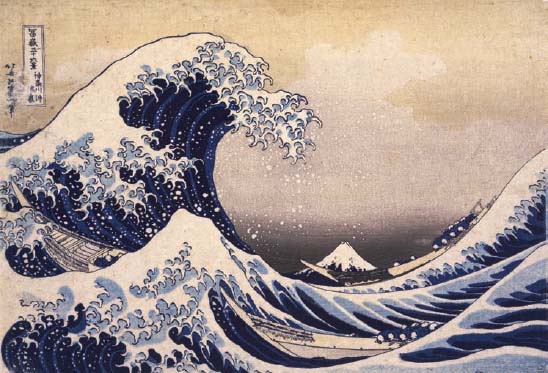From the Industrial Revolution to World War I, C. 1850–1914Japanese Art |
What is the difference between the work of Hokusai and Hiroshige? |
Katsushika Hokusai (1760–1849) and Utagawa Hiroshige (1797–1858) were two of the most successful landscape painters in nineteenth-century Japan, and their prints are among the most recognizable examples of graphic art in the world. Both artists explored the transience of the material world in their ukiyo-e paintings. Hokusai was especially well known for his series, Thirty-Six Views of Mount Fuji. His print, The Great Wave off Kanagawa represents a monumental wave cresting with stylized foam, about to crash near a group of men in long, graceful boats shaped to mirror the curves of the ocean swells. Appearing unexpectedly in the background is the distant image of snow-capped Mount Fuji, which lies low along the horizon line. The white peak of Mount Fuji looks similar to a white-capped swell in the foreground, making the formidable mountain appear as temporary as an ocean wave. The Great Wave is an example of Hokusai’s use of the European color, Prussian blue, and demonstrates the simplicity and dynamism of Japanese art during the Edo period.
Like Hokusai, Hiroshige was a master of the Edo period who specialized in landscapes. Some of his prints also include images of Mount Fuji, including View of Mount Fuji from Satta Point in the Suruga Bay (1589), a woodcut that depicts a curling wave similar to the one painted by Hokusai. Hiroshige was almost forty years younger than Hokusai, and was greatly inspired by the older artist’s work. Among his most famous works were his prints for the series, One Hundred Views of Edo (1856–1859), which were completed by his student, Hiroshige II. His prints often rely on an understanding of perspective to create depth and his style had a major impact on Dutch artist Vincent van Gogh, who created an oil painting based on Ohashi Bridge in the Rain in 1887. Hiroshige’s street scenes in prints such as Night View of Saruwaka-machi (1856) also inspired Impressionist artists such as Auguste Renoir and Camille Pissarro. Hiroshige was working in Japan at a time when the country was opening its doors to the outside world after centuries of isolation, and his work captures the changes occurring in the nineteenth century through a lens of the ukiyo-e tradition.

Katsushika Hokusai was an important ukiyo-e artist of the nineteenth century. His now iconic image, The Great Wave off Kanagawa, commonly known as “The Wave,” is a woodblock print and part of a series of prints he called Thirty-six Views of Mount Fuji. The mountain can be seen in the background, seemingly smaller than the mighty wave in the foreground.
